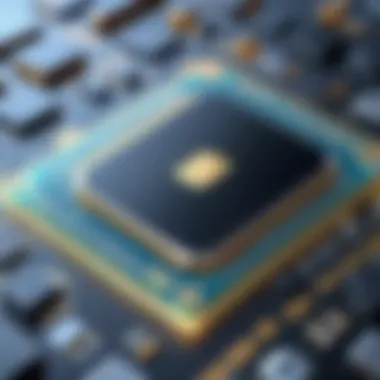Understanding Passport Background Remover Technology


Intro
In an increasingly interconnected world, passport photos have become a crucial element of international travel. The demand for high-quality images resonates across various platforms, from government forms to personal identification. To achieve the necessary quality, passport background remover technology emerges as a vital tool. This technology allows users to remove distracting backgrounds and focus on the subject, ensuring compliance with official requirements.
Understanding how this technology works is essential for those wishing to navigate the complex arena of passport images effectively. From its practical applications in the travel industry to its illustrated methodologies, each layer of this technology provides insights into its broader impact on both individuals and businesses.
The significance of this technology extends beyond mere aesthetics. It directly influences the efficacy of identity verification processes. In examining passport background remover technology, one must consider the ethical implications that arise from its use. This article will delve into key features, specifications, and the ethical considerations surrounding this technology, offering readers a comprehensive understanding of its operational foundations.
Preamble to Passport Background Remover
In today’s visually driven world, the presentation of identification documents, specifically passports, has gained paramount importance. An essential aspect of this presentation is the background of passport photos. A clean, consistent background enhances the professionalism of these documents. Thus, the use of background remover technology has become increasingly relevant.
The passport background remover is not merely a tool; it is a necessity for anyone involved in capturing or managing passport photographs. This technology plays a critical role in ensuring compliance with legal standards and professional quality expectations for identification documentation.
Importance of Background Removal
- Professional Standards: Many countries have stringent regulations governing the appearance of passport photos. Accurate adherence to these standards is essential for the acceptance of passport applications. Background removal technology helps in creating images that meet these professional benchmarks.
- Consistency Across Various Applications: Passport photos are often required in a variety of professional contexts—from business travel to government identification. Ensuring a uniform quality of these photos through background removal maintains a standard that is both recognizable and trustworthy.
- Cultural Sensitivity: Different cultures have unique expectations and norms related to identity presentation. Background removal allows for the customization of images, ensuring that they resonate with local standards while still adhering to international requirements.
The technology itself operates on the principles of image processing, machine learning, and artificial intelligence. These technologies analyze images to distinguish between the subject and the background effectively, ensuring a clean, clear representation of the individual.
The End of This Section
In summary, the necessity of using passport background remover technology extends far beyond aesthetics. It is pivotal in ensuring compliance with professional standards, achieving consistency, and respecting cultural relevance in the presentation of identification photos. This segment lays the groundwork for understanding the intricate technologies that facilitate background removal and their broad applications in various sectors.
The Necessity of Background Removal
Background removal is a crucial element when it comes to creating professional passport photos. The significance of this process extends beyond aesthetics. It involves meeting strict regulatory requirements that ensure consistency, clarity, and professionalism. Properly executed background removal allows for a clean presentation of the subject, ideal for identification purposes across various governmental and legal frameworks. This necessity is not merely a choice; it is an obligation in many scenarios where misleading imagery can result in questions about identity.
Professional Standards for Passport Photos
Professional standards for passport photos vary by region, but they universally dictate that the background must be neutral and free of distractions. In many countries, passports must adhere to specific guidelines outlined by the International Civil Aviation Organization (ICAO). This often includes criteria such as:
- Color Requirements: The background should be white, light gray, or light blue.
- No Shadows or Patterns: The background must be uniform, without shadows, patterns, or textures that could detract from the subject’s features.
- Head Positioning: The subject's head must be properly aligned, and background removal plays a vital role in making sure the dimensions are appropriate.
Utilizing an efficient background remover technology ensures compliance with these guidelines. Non-compliance can lead to delays in application processing, rejections, and unforeseen complications when traveling.
Cultural and Regional Variations
Cultural and regional preferences influence passport photo requirements and expectations. While many nations follow ICAO guidelines, there are also local variations that reflect unique cultural contexts. Some considerations include:
- Color Preferences: Different regions may prefer varying shades or colors for backgrounds. What is acceptable in one culture might not hold the same standing in another.
- Facial Expression Requirements: Some cultures allow smiles or slight expression differences in identification photos, requiring careful management while editing backgrounds to preserve authenticity.
- Regulatory Nuances: Different countries may have peculiar regulations concerning photo submissions, further complicating the need for meticulous background removal.
Understanding these variances is essential for anyone engaged in the creation of passport photos. It not only streamlines the process but also helps individuals avoid the potential pitfalls associated with non-compliance.
Technological Foundations of Background Removal


Understanding the technological foundations of background removal is crucial to appreciating how passport photos are enhanced today. With the rise of digital photography, professionals and amateurs alike seek high-quality images that adhere to strict standards. Background removal technology helps achieve this by isolating subjects from distracting backgrounds. This section delves into the core aspects of this technology and its implications for various users including photographers, government agencies, and everyday individuals.
Image Processing Algorithms
Image processing algorithms are fundamental to background removal technology. These algorithms analyze pixel data and identify areas that need manipulation. Various methods are employed:
- Thresholding: This technique distinguishes between background and subject by setting a brightness threshold. Pixels above the threshold are classified as the subject, others as the background.
- Edge Detection: Algorithms like Sobel or Canny enhance borders between objects and background. This step is crucial for accurately defining the subject’s outline.
- Segmentation: Involves partitioning an image into parts for easier analysis. Each segment can then be individually manipulated, which aids in refining background removal.
The efficiency of these algorithms directly impacts the final image quality. Better algorithms result in cleaner edges and more accurate background removal, making them vital in producing professional-grade passport photographs.
Machine Learning Techniques
Machine learning has revolutionized several industries, including image editing. For background removal, these techniques utilize large sets of marked data to ‘teach’ models to recognize subjects in images. Key aspects include:
- Training Models: Algorithms are trained using thousands of images with various backgrounds. This process helps the model learn how to distinguish between the subject and the unwanted background effectively.
- Neural Networks: Deep learning models, particularly convolutional neural networks, excel in complex image tasks. They adaptively learn patterns in pixel arrangements, improving accuracy in identifying subjects.
- Real-Time Processing: Advanced models can apply background removal in real-time. This functionality is particularly useful for users who demand immediate results, such as during events or instant uploads to social media.
Incorporating machine learning into background removal allows for more nuanced decision-making compared to traditional algorithms. This results in a more intuitive, user-friendly experience.
Artificial Intelligence in Image Editing
Artificial intelligence (AI) enhances background removal techniques significantly. AI-driven tools offer several advantages:
- Automation: Many background removal tools powered by AI can operate autonomously, reducing the need for manual adjustments. This streamlines the photo editing process.
- Adaptive Learning: AI systems continually learn from user inputs and corrections. This adaptive learning allows for increasingly accurate background choices, even in poorly lit or complex compositions.
- User Accessibility: With AI, even non-professionals can achieve desirable results without extensive training in photo-editing software. Simple interfaces and guided processes make it accessible for a wider audience.
AI not only simplifies the background removal process but also enhances the quality and precision of the outcomes.
Different Methods for Background Removal
The capacity to effectively remove the background from passport photos is essential. This allows for clarity and professionalism in official documents. Various methods exist to achieve background removal, each having its own significance and implications. Understanding these methods can help users choose the most appropriate approach based on their needs and resources.
Manual Techniques
Manual background removal is the most traditional approach. This method involves using editing software to meticulously eliminate the background pixel by pixel. Programs like Adobe Photoshop or GIMP offer tools like the lasso tool or the pen tool, which allow users to outline the subject precisely.
The primary advantage of manual techniques is control. Users can make detailed adjustments, ensuring high standards for the photo. However, this comes with downsides, including time consumption and the requirement for skill and practice.
Key considerations include:
- Requires knowledge of photo editing software.
- Can be time-intensive, especially for novice users.
- Quality depends on the user's proficiency.
By mastering these skills, one can achieve stunning results, but the learning curve may deter casual users.
Software Solutions
Software solutions for background removal offer a middle ground between manual methods and online tools. These solutions often combine automation with user input. For instance, programs like Adobe Photoshop Elements provide guided processes for removing backgrounds. They often include sophisticated algorithms that help users isolate the subject more quickly than manual techniques.
Advantages of software solutions include:


- Faster than purely manual methods.
- Accessibility for users with varying skill levels.
- Offers advanced editing features, like background blur or replacement.
Choosing the right software can significantly enhance the quality of photos while saving time.
Online Background Remover Tools
Online tools for background removal have surged in popularity due to their convenience. Services such as remove.bg or Canva allow users to upload photos and receive backgrounds removed almost instantly. The underlying algorithms are often powered by AI, enabling quick processing without needing extensive software knowledge.
"Online tools bridge the gap by providing instant results with minimal user effort, making them appealing for the average consumer."
Benefits include:
- No need for installation or extensive knowledge.
- Real-time processing can save considerable time.
- User-friendly interfaces cater to beginners.
However, users must consider the limitations, such as variable quality and the potential for privacy concerns regarding uploaded images. In summary, the choice of method largely depends on the user's skill, desired quality, and the specific context in which the images will be used.
Applications of Background Removal Technology
Background removal technology plays a pivotal role in various sectors by enhancing image quality and ensuring compliance with professional standards. This technology has transformed how users, both in personal and professional environments, engage with digital photography. The applications are diverse, ranging from legal requirements to social media aesthetics, and they indicate the significance of this technology in today’s digital landscape.
Government and Legal Use Cases
In government and legal domains, precise images are crucial. Passport photos must meet strict guidelines. The background needs to be uniform and non-distracting. This allows for facial recognition systems to work effectively. For instance, the U.S. Department of State mandates specific dimensions and background color standards for passport photos. Using background removal technology ensures compliance. Thus, individuals cannot afford inaccuracies in these settings.
- Correct background removal improves the success of identity verification.
- It protects against potential identity fraud, as consistent backgrounds enhance biometric data accuracy.
This application goes beyond just passport photos. Legal documents often require photographs for identification. Clear, standard-compliant images help streamline processes at government facilities. So, the need for accountability heightens the necessity of background removal technology within this arena.
Personal Use and Social Media
On a personal level, background removal technology significantly influences social media engagement. Many users strive for visually appealing profiles or posts. A clean background can greatly improve image focus, allowing subjects to stand out. Applications like Adobe Photoshop and services like Canva provide intuitive tools that enable users to create attractive images.
- Users can enhance their online presence by presenting professional-looking photos.
- This fosters a sense of credibility and individuality within personal branding efforts.
Moreover, individuals often utilize this technology for event memories. Whether it’s a graduation or a wedding photo, removing unwanted backgrounds helps highlight special moments. As a result, more users are drawn to tools that can effectively handle these tasks. Individuals no longer need to be professional photographers to achieve high-quality results.
Commercial and Marketing Industry
In the commercial sector, background removal technology has become essential for effective marketing strategies. Businesses rely on clean product images to attract customers. E-commerce platforms, such as Amazon and eBay, often require images that conform to specific standards, including uniform backgrounds. High-quality visuals can entice consumers and improve conversion rates.
- Consistent and well-edited images boost brand recognition and trust by presenting a polished image.
- Marketers can create compelling advertisements that align with brand aesthetics, enhancing overall consumer engagement.
Additionally, creative campaigns in advertising benefit significantly from background removal. Brands can merge multiple elements into one cohesive design, drawing attention and prompting consumer action. In essence, this technology allows companies to present their offerings in the best possible light, ensuring they remain competitive in ever-evolving markets.
The impact of background removal technology reaches across various fields, shaping how individuals and organizations represent themselves and interact within digital environments.


Potential Challenges and Limitations
The evolution of passport background remover technology presents various advantages, yet it also introduces specific challenges and limitations that are essential to acknowledge. Understanding these aspects is crucial not only for developers and service providers but also for end-users who increasingly rely on these tools for sensitive applications like passport photo submission. Being aware of these challenges can guide improvements in technology and ensure adherence to ethical standards.
Technical Limitations in Image Quality
When using background remover technology, the quality of the final image can be a significant concern. Despite advances in algorithms and software, image processing is still subject to several constraints. Factors such as lighting conditions, image resolution, and the complexity of the background can affect the output.
- Lighting Conditions: Non-uniform lighting may cause shadows or glare. Both these issues can mislead algorithms during the extraction process, resulting in blurred or poorly defined edges.
- Image Resolution: Low-resolution images may lead to loss of detail once the background is removed. Important features, such as facial expressions, may be compromised during enhancement.
- Background Complexity: A background with intricate patterns can make it difficult for the software to distinguish between elements. This can result in parts of the foreground object being incorrectly categorized as background, leading to inaccuracies.
Furthermore, some automated tools may struggle to maintain the natural appearance of the subject after the background has been altered. Users may notice pixelation or artifacts in their images, which detracts from the professionalism often required in passport photos.
Ethical Concerns and Misuse
The application of passport background remover technology raises ethical concerns that merit serious attention. With the overall ease of accessing and using these technologies, potential misuse becomes a significant worry. Users might employ background removal improperly, manipulating images for deceptive purposes.
- Identity Fraud: One of the most pressing issues is the risk of identity fraud. People may attempt to use altered passport photos to assume false identities. This manipulation can lead to severe legal repercussions and compromise national security.
- Cultural Sensitivity: Removing backgrounds indiscriminately can lead to cultural sensitivity issues. The background may carry important contextual significance. Thus, the removal might distort the representation of individuals from different cultural or geographical backgrounds.
- Privacy Implications: Users may inadvertently share sensitive images on public platforms, which can lead to unauthorized usage of their likeness or personal data.
"Understanding the potential for misuse in the realm of technology is just as crucial as recognizing its benefits."
In summary, while passport background remover technology offers convenience and efficiency, it is accompanied by challenges regarding image quality and ethical usage. A balanced approach, which emphasizes continual improvement in technology while maintaining vigilance against potential misuse, is vital for the effective application of this technology.
The Future of Passport Background Removal Technology
As technology advances, the field of passport background removal is poised for significant transformation. This discussion highlights key elements that could shape the future of this technology. Improved accuracy, speed, and overall user experience are critical benefits that can enhance the process of creating passport photos. Given the global nature of travel and increased scrutiny in identification processes, advancements in this sector are both timely and essential.
Innovative Trends on the Horizon
Recent developments suggest a few innovative trends in passport background removal technology. One notable trend is the increased utilization of cloud computing. With cloud platforms, users can access powerful image processing capabilities without needing advanced hardware. This means that even those with standard personal computers can easily process images effectively.
Another emerging trend is the integration of real-time background removal capabilities into mobile applications. As smartphones become more advanced, apps may soon allow users to click a photo and instantly remove the background, producing a professionally acceptable passport image within seconds. This would cater to the growing demand for efficiency in an instant gratification society.
Furthermore, enhanced algorithms for edge detection are becoming standard. These algorithms will allow finer details of a subject to be captured and presented accurately, notably improving the quality of the end image. This enhances user trust, especially in sensitive applications such as passport verification.
Improvements in User Accessibility
A focus on user accessibility is also crucial. Current software and tools can be complex, often deterring users from harnessing their full potential. The design of more intuitive user interfaces is essential. Simplifying the process of background removal will allow users, regardless of technical proficiency, to achieve high-quality results.
Moreover, educational resources are becoming more important. Tutorials, FAQs, and support channels will help users navigate the technology effectively. Providing these resources ensures that individuals feel empowered when using these tools.
Closure
The conclusion of this article serves as a critical synthesis of the information presented throughout the discussion on passport background remover technology. It encapsulates the significance of understanding this technology in the context of both personal and professional uses. As passport photos remain a vital aspect of identification, the necessity of high-quality images cannot be overstated.
Background removal technology not only enhances image quality but also ensures compliance with strict guidelines for passport photographs set forth by various governmental agencies. By using advanced image processing algorithms and machine learning techniques, the technology guarantees precision in isolating subjects against the backdrop. This precision helps to produce clear and professional photographs that meet the expected standards.
In today's digital age, the accessibility of this technology means that almost anyone can create suitable passport photos. This democratization holds significant benefits for users, especially those who may not have the time or resources to visit a professional photographer.
However, it is equally important to consider the ethical implications associated with the misuse of this technology, such as identity fraud or the generation of unauthorized documents. Awareness of these concerns highlights the need for responsible use.
Ultimately, as this technology continues to evolve with innovations on the horizon, it is crucial to stay informed about its capabilities and limitations. The knowledge gained here not only aids individuals but also helps businesses and organizations leverage background removal technology effectively. Understanding the ongoing advancements will position users to make informed decisions about which tools and platforms best meet their needs.
"The ability to create professional-looking images from the comfort of one's home is a game changer, but it comes with the responsibility of ethical usage."



